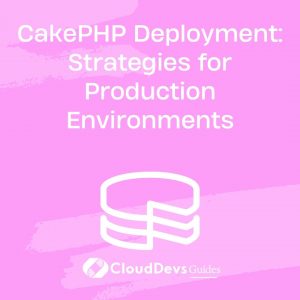CakePHP Deployment: Strategies for Production Environments
CakePHP is a powerful and popular PHP framework that simplifies web application development. Once you have built your application, the next crucial step is to deploy it to a production environment where it can handle real-world traffic and users. Deploying a CakePHP application to a production server requires careful planning and implementation to ensure a seamless user experience and to avoid potential downtime or performance issues. In this blog post, we will explore various strategies for deploying CakePHP applications in production environments.

Table of Contents
1. Understanding the Production Environment
Before diving into deployment strategies, it’s essential to understand the production environment where your CakePHP application will reside. Typically, production servers differ significantly from development environments, and considering these differences is crucial for successful deployment.
1.1 Server Infrastructure
Identify the type of server infrastructure you will be using, such as cloud-based platforms like AWS, Azure, or traditional dedicated servers. Understanding the server’s resources, scalability, and performance capabilities will influence your deployment approach.
1.2 Web Server and PHP Configuration
Ensure that your web server (e.g., Apache, Nginx) and PHP settings align with CakePHP’s requirements. Check PHP version compatibility, necessary extensions, and recommended configurations to avoid compatibility issues during deployment.
1.3 Database Setup
Verify that the production database server is correctly configured, optimized, and accessible from your application’s server. Use appropriate database credentials and connections to establish a secure and reliable connection between your CakePHP application and the database.
2. Choose the Right Deployment Method
CakePHP applications can be deployed using various methods, each with its advantages and considerations. Let’s explore some popular deployment methods.
2.1 Manual Deployment
Manual deployment involves uploading your application files to the production server manually. This method is suitable for small projects or when you have limited access to the server. Here’s a step-by-step guide:
Step 1: Compress your application files
Create a ZIP or TAR archive of your CakePHP application, excluding unnecessary files such as development-specific configurations and cache.
Step 2: Upload to the server
Use secure file transfer methods like SFTP or SCP to transfer the compressed file to the production server.
Step 3: Extract and set permissions
Extract the files on the server and configure file permissions appropriately. Ensure that the web server has the necessary permissions to read and write to specific directories.
Step 4: Install dependencies
Install the required PHP dependencies using Composer and set up the production database.
Step 5: Configure server settings
Update the server configuration to point to the CakePHP webroot directory as the web server’s document root.
Step 6: Test the application
Perform thorough testing to ensure the application functions correctly on the production server.
2.2 Git Deployment
Git deployment automates the deployment process and allows for version control integration. This method is suitable for medium to large projects with multiple developers working on the codebase.
Step-by-Step Git Deployment Process
- Set up a Git repository for your CakePHP application.
- Configure the production server to have a Git remote repository.
- Set up a webhook or CI/CD pipeline to automatically trigger deployments whenever new code is pushed to the repository.
- On the server, pull the latest changes from the Git repository and install/update dependencies using Composer.
- Perform necessary database migrations or updates.
- Run tests to ensure the application is working correctly.
2.3 Docker Containers
Docker is a popular containerization platform that allows you to package your application along with its dependencies into a container image. This image can then be deployed on any server with Docker support.
Docker Deployment Steps
- Create a Dockerfile that defines the application’s environment and dependencies.
- Build the Docker image using the Dockerfile.
- Push the image to a container registry (e.g., Docker Hub, AWS ECR).
- Pull the image on the production server.
- Use Docker Compose or Kubernetes to manage containers and deploy the application.
Docker simplifies deployment by ensuring consistency across different environments and easing scalability.
3. Implementing Zero-Downtime Deployments
One of the critical aspects of production deployments is to minimize or eliminate downtime to maintain an uninterrupted user experience. Zero-downtime deployments ensure that the application remains available during the deployment process. Here are some strategies to achieve zero-downtime deployments with CakePHP:
3.1 Rolling Deployments
In a rolling deployment, new application instances are deployed while old instances continue to serve traffic. This gradual switch ensures that there is always an operational version of the application.
bash
# Sample rolling deployment script
for server in app-server1 app-server2 app-server3; do
# Deploy new version to $server
ssh user@$server 'cd /var/www/cakephp-app && git pull origin master'
# Run database migrations
ssh user@$server 'cd /var/www/cakephp-app && bin/cake migrations migrate'
# Restart the web server or PHP-FPM
ssh user@$server 'sudo systemctl restart apache2'
# Wait for the server to come back online before moving to the next server
sleep 10
done
3.2 Blue-Green Deployments
Blue-Green deployments involve running two separate environments, one active (Blue) and the other inactive (Green). During the deployment, traffic is redirected from the Blue environment to the Green environment once it is fully operational.
nginx
# Nginx configuration for Blue-Green deployment
server {
listen 80;
server_name example.com;
location / {
# Redirect to the Green environment
proxy_pass http://green_server;
}
}
server {
listen 80;
server_name example.com;
location / {
# Redirect to the Blue environment
proxy_pass http://blue_server;
}
}
Conclusion
Deploying a CakePHP application to a production environment is a critical phase that requires careful planning and consideration of various strategies. Understanding the production environment, choosing the right deployment method, and implementing zero-downtime deployment strategies are essential for maintaining a stable and reliable web application.
Remember to regularly test your deployment processes, monitor the application’s performance, and keep up with the latest CakePHP updates to ensure your web application runs smoothly and efficiently in production. Happy deploying!
Table of Contents








